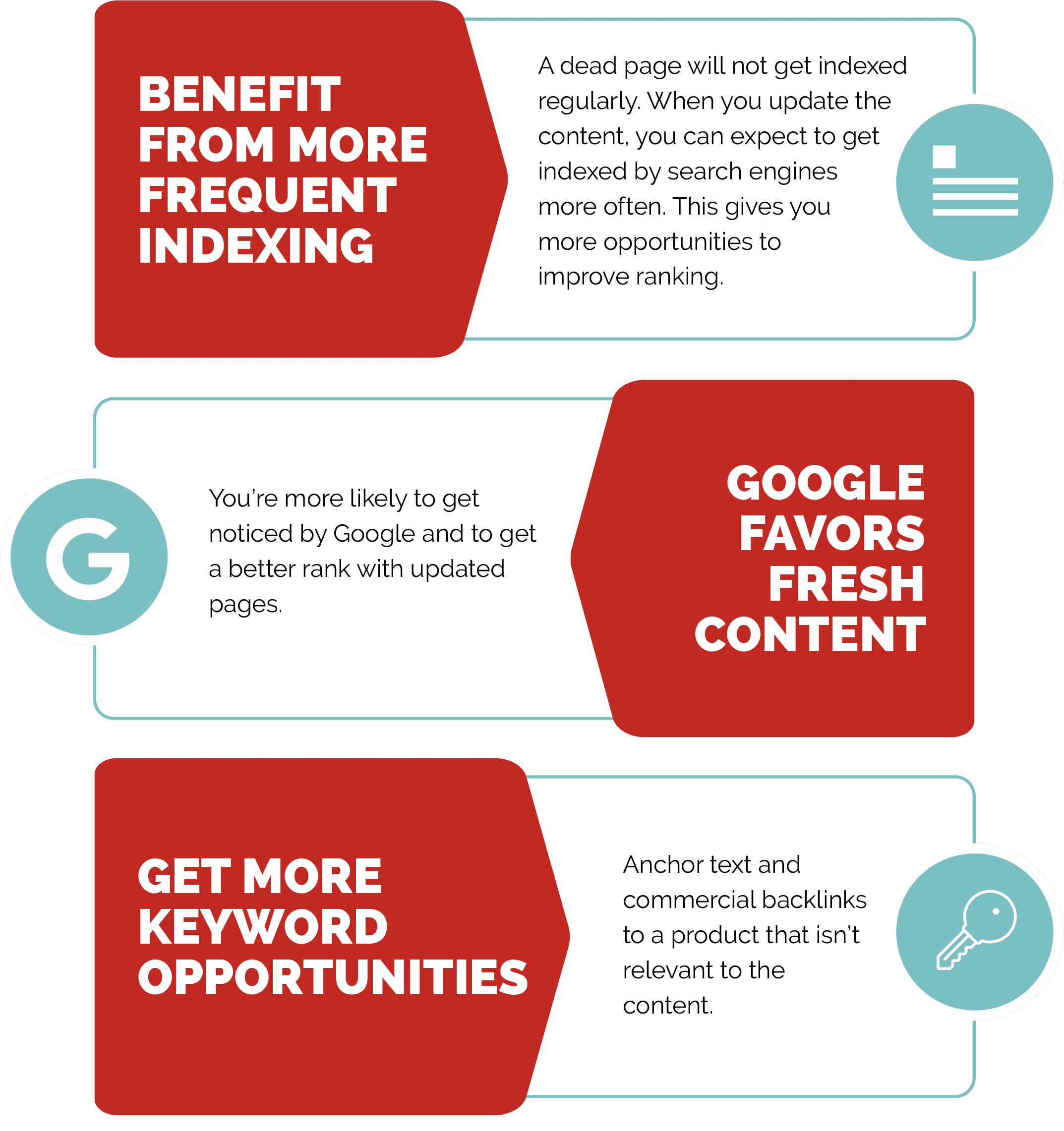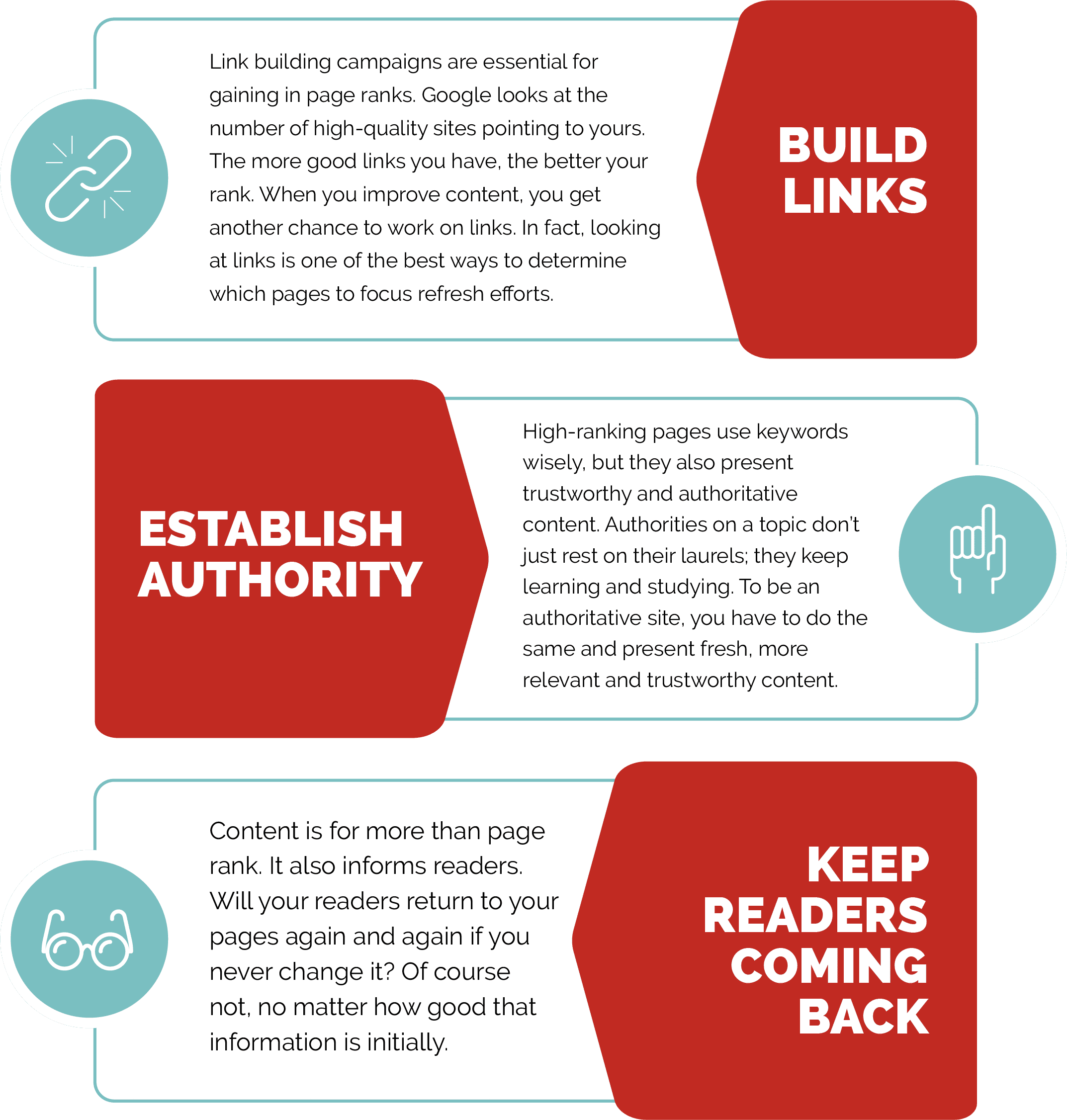No matter how valuable a page of content is, the search volume and rank will begin to decline at some point in the future.
Refreshing content is essential for maintaining traffic and rankings. It is also important for attracting natural links.
You can refresh every page you have, but some pages will need it more than others.
Here are some tips for prioritizing and refreshing the pages that matter.
What is a Content Refresh? And Why is it Important?
Evergreen content is essential for cultivating a steady stream of organic and referral traffic.
This is the kind of content that readers will always need and does not go out of date.
Typical evergreen content can be historical in nature (this event happened, this person said that), but it can also be task-related. For example, how to change a lightbulb or how to lose weight by counting calories has remained relatively steady over the years.
You need this kind of content because it brings a steady and dependable amount of traffic with content that rarely goes out of date.
Pages that are related to current events or interests are called topical. A topical page on COVID-19 updates may bring a surge of traffic, but eventually, that will trail off. A page about how to lose weight without dieting will remain relevant almost forever. A mix of topical and evergreen content can maximize your search rank and traffic.


And though evergreen content is for “almost forever,” it still needs to be reviewed for an update for several important reasons:
- Users favor up to date content — Even evergreen topics are subject to changing trends. Always know current user trends. Google’s algorithms are tuned to satisfying users.
So if your evergreen content reflects current trends, then Google is more likely to show that content because it’s what users expect to see. You will always win by focusing on publishing content users expect to see.
- Get more keyword opportunities — Refreshed content creates the opportunity to expand on ranking and search traffic.
- Build links — Links are beneficial to ranking. When you improve the content, you get another chance to acquire more links.
Reviewing what other sites are linking to today can provide insights into how a page can be refreshed in order to attract more links. For example, if websites are increasingly linking to pages containing information about a current trend, updating that page to include that information may attract those links they would not have otherwise been eligible for.
- Establish authority — High-ranking pages use keywords wisely, but they also present trustworthy and authoritative content.
Authorities on a topic keep up to date and evolving. An authoritative site discusses current perspectives on a topic. This keeps the content relevant to people and reinforces the perception and quality of trustworthiness.
- Keep readers coming back — Good content is useful. Good content reflects what people want to do and what they want to be. Refreshing older content helps keep up with users evolving desires and aspirations. And this helps keep those pages ranking as the algorithms shift to satisfy those needs.
Start with Pages with Unlinked Mentions
All pages should come under review for refreshing regularly. But you can’t do it all at once, so some pages take precedent.
A significant factor is unlinked mentions. An unlinked mention is when your brand or a brand you sell is cited on web pages but without a link. That represents an opportunity to convert those mentions to links to a specific page.
For example, if you’re selling Pilates equipment and have several pages with different products. The ideal approach is to build links to the pages/products with the most brand mentions.
So if health and fitness blogs are mentioning the Pilates reformer more than they do the Pilates chair, for instance, then the reformer page gives you more opportunities to build links.
While building links to both is ideal, focusing on the most popular product, as evidenced by the number of mentions, may keep you current with consumer demands and desires.
In the above example, refreshing the content on that page about how to use reformers in order to reflect changing trends will help to win those links.
And remember, images are content too. So doing something like adding images featuring people who resemble the top consumers of a product can be helpful.
Other Signs a Page Could Use a Refresh
Unlinked brand mentions provide a useful jumping-off point for starting a content refresh project. But there are other factors to consider.
Pages, articles, blogs, and other types of content that would benefit from an update may have:
- Statistics or data that are out of date,
- Old screenshots,
- Broken or irrelevant links,
- A title that literally dates the page,
- Poor writing quality or thin content,
- A drop in search volume that can’t be explained by seasonal trends or newsworthiness,
- Declining page views, or
- A drop in search ranking.
While all of your evergreen pages should be refreshed regularly, these factors will show you the areas of greatest need.
Of course, also consider a refresh of your site that includes not just updating existing pages but adding new pages as well. Use keyword and competitor analysis to find topics you’re missing on your site.
Tools to Help Identify Target Refresh Pages
The concept of finding pages to refresh is simple. Using the right tools helps to accomplish this task efficiently.
If you already have accounts with some of the top SEO tools, you may already have what you need to get started. Google also provides some useful free tools.
Searching for Brand Mentions
For finding brand mentions just waiting to become backlinks, you can use Ahrefs or Moz, two of the most comprehensive SEO tools on the market, or Google, which of course, is free.
Searching for brand mentions on Google is simple. Type in your brand name in quotes, followed by a space, a negative sign, and your domain name.
For instance, Balanced Body brand of Pilates equipment is sold at the site Pilates.com.
A search query that excludes Pilates.com to find brand mentions that don’t include those on their own site would look like this:
“balanced body pilates” -pilates.com
Also, exclude domain names like Facebook, Twitter, and similar sites, so you avoid getting a lot of brand mentions coming up that you can’t use. Add the free Moz bar to your browser so you can export the results of your search.
With a Moz Pro account, you can use their Fresh Web Explorer to do your brand mention search. It gives you brand mentions dating back up to four weeks.
At Ahrefs, use Content Explorer to search your brand mentions. This will give you the pages as well as the authors and websites, and different languages.
Finding Broken Links
Broken links are links to your web page that, for whatever reason, were coded wrong, resulting in links to non-existent pages.
Failure to keep up on finding broken links can lead to poor user experience and an inability for your site to attain its full ranking potential.
A way to identify broken links to your site is to investigate 404 Page Not Found errors. Each time someone follows a broken link to your website, your site generates a 404 Page Not Found response.
Suppose your site is on the WordPress platform, and you already have the Redirection WordPress plugin installed. In that case, you can review the plugins 404 error report to identify any potential broken link opportunities.
You can also use Google Analytics to do a regular link check. It allows you to set a period of time, for instance, one month since the last test. Use the title of your domain’s error page to track down all the links that lead to it.
Search Engine Results Pages
Another useful metric for deciding on pages to refresh is Search Engine Results Pages (SERPs).
Check the SERPs for your topic or keyword in a tool like Ahrefs. If competitor pages have jumped ahead of yours, it could be a sign that you need a refresh.
Compare your flagging page to those competitor pages to see what those pages have that your pages are missing.
Ahrefs also has a tool known as Content Gap. It will show you the keywords that those other top-ranking pages rank for that you do not.
This may indicate that your page is missing a critical subtopic. It tells you that the page needs a refresh and exactly how to do it.
Add in the new subtopic to boost the page. Remember to discuss that subtopic in the same way users are talking about and searching for it.
Tracking Metrics
Any useful SEO tool will help you track metrics for your pages. Ahrefs is one of the best on the market, and by using it, you can look at things like search volume for your pages.
If you see volume dropping off steadily for one page more than another, that page could benefit more from a refresh.
Track page views, ranking, backlinks, and other metrics that indicate a piece of content is getting stale.
Content Refreshes are an Essential Part of SEO
There is no set-it-and-forget-it for great pages. Keep them up to date and relevant to user trends to avoid losing rankings, page views, links, and ultimately clicks and sales.
Focus efforts first on pages that really need it, but regular updates to all pages are best.




